This is no mere great white copy; Patton the Megalodon is a grade-A movie monster, a hulking brute with commanding shelf presence.
Let’s face it: people love apex predators. We’re scared of them, sure, but we also admire them and get excited by them. Sharks are one group of predators we humans seem particularly drawn to, and their fossil record shows a long history which eclipses the age of dinosaurs by a mile. Not surprisingly, among all the weird and wonderful species known to science, the one that has garnered the most attention is Megalodon, possibly the biggest, most fearsome shark of them all.

Not much is actually known about the appearance of Megalodon (its genus has changed from Carcharodon to Carcharocles and currently to Otodus). Shark skeletons are cartilaginous and don’t fossilize well, so only the creature’s numerous huge teeth and a few vertebrae exist for study. Generally speaking, Megalodon is regarded as being one of the largest marine predators known in history, with evidence from coprolites and bite marks revealing the giant as a whale hunter. Most reconstructions depict the animal as a giant lamnid shark, comparing most closely to the modern great white. This raises something of a challenge for toy companies, though: how does one make a Megalodon model that actually looks like a Megalodon, and not just an oversized living shark?

PNSO, a growing star of a brand among dinosaur collectors, did their own take on the “mega tooth” back in 2016 before the company went off the grid; they then re-released it when the company revived in late 2017. Known for their museum-grade attention to detail and scientific accuracy, PNSO took a different approach from other companies for their Megalodon: they made it look as big and nasty as they could. Massive jaws agape, with wrinkled and scarred hide, this Megalodon is a grade-A movie monster, ready to destroy anything in its sights.
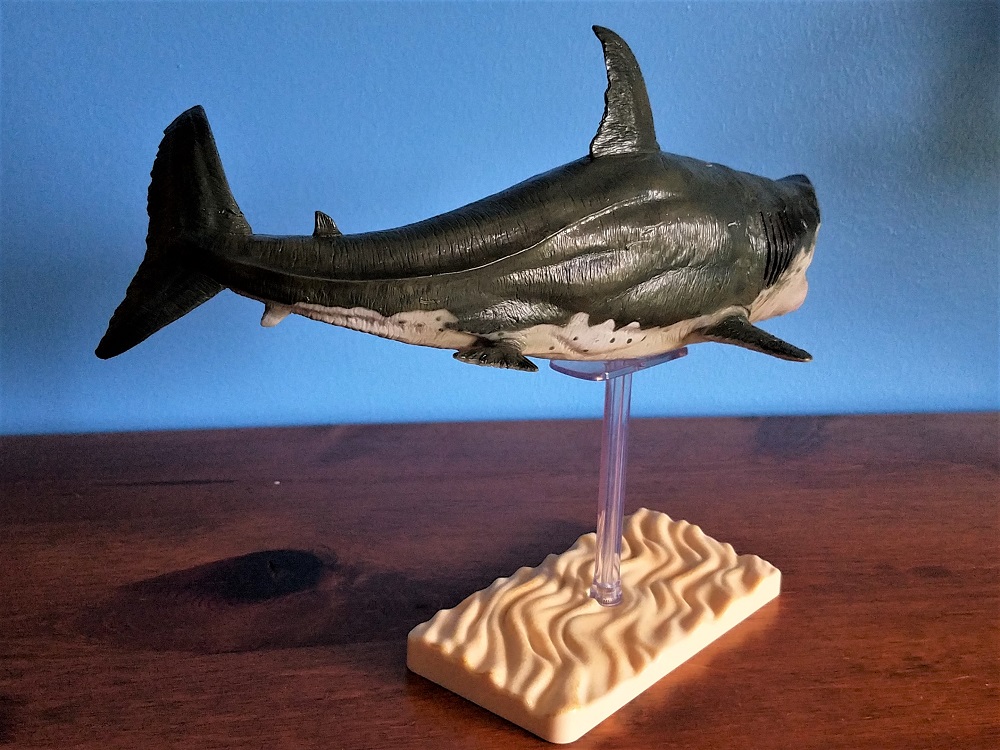
PNSO’s “Patton” the Megalodon comes boxed with a two-part stand. The box itself features a nice illustration of the shark patrolling the ocean depths. Inside the box are compartments separating the main figure and the stand pieces. A screw is included to attach the clear pole to the base. The base resembles a sandy ocean bottom, but it’s a hollow and somewhat flimsy plastic piece. The stand rests underneath the belly of the figure, but doesn’t particularly fit the shape, so the potential exists to dislodge Patton from their stand if one is not careful. Overall, the stand is pretty cheaply designed, but it works well enough for its purpose. I imagine most buyers will be less concerned about the stand and far more interested in Patton themself.
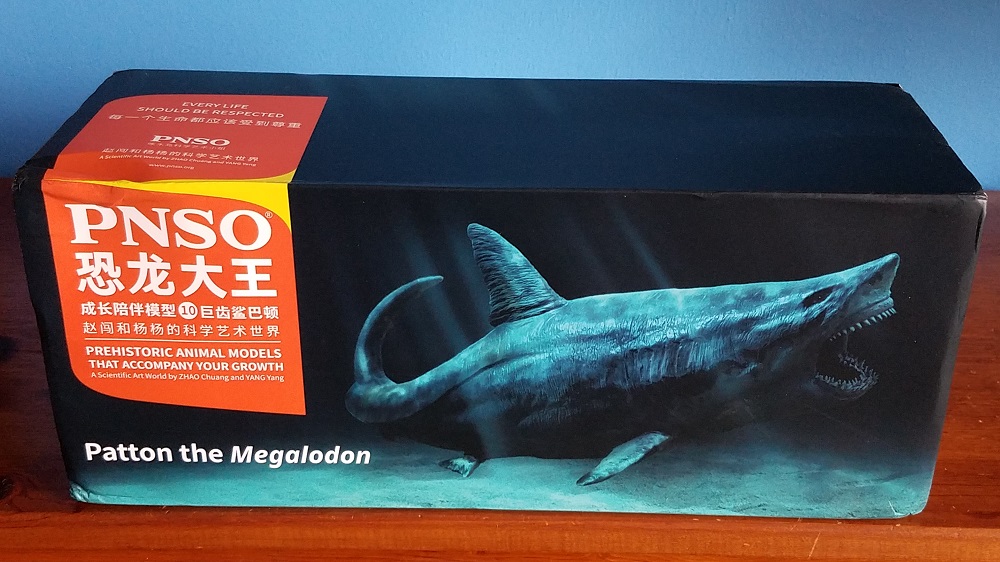
This is a thoroughly voluminous figure that measures 14 inches long even without the curve in the tail. The girth of the main body is roughly 3 inches, and from belly to top fin, it measures about 4.5 inches tall – this is a THICK shark. Estimates on Megalodon’s true size vary greatly, so the scale of this model could range between around 1:30 to 1:50, depending on how “mega” you like to think this mega-predator could have been. Even without its stand, Patton is sure to have a commanding presence on one’s display shelves amongst other models of prehistoric sea life and ancient predators.
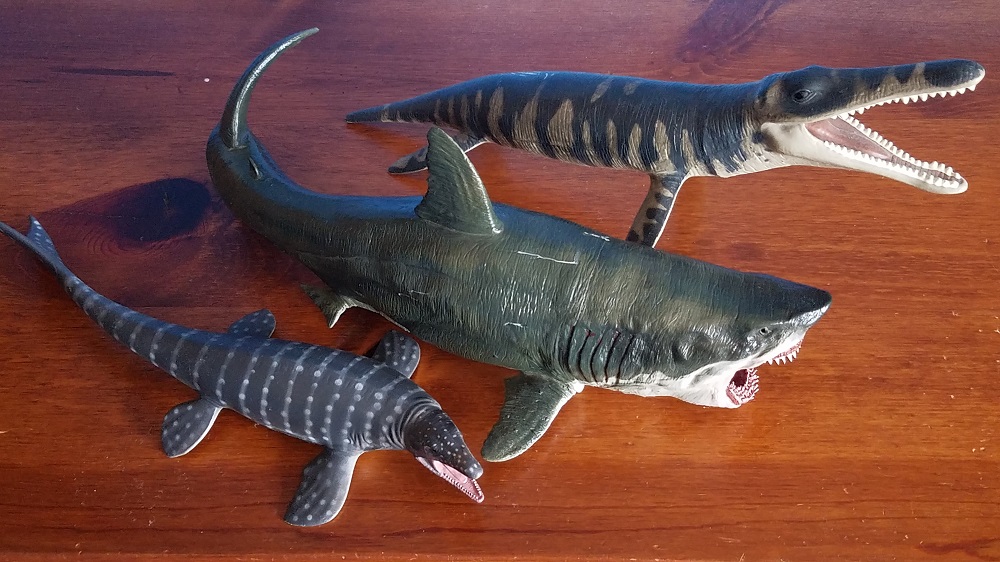
Several other companies have tried their hand at Megalodon before or since PNSO, but most end up resembling other great white shark toys on the market. Patton, even at a glance, is no ordinary modern shark; this Megalodon is a hulking brute. General proportions are familiar enough, and are ultimately guesswork due to the dearth of hard fossil evidence. What we do know from fossilized vertebrae is that Megalodon would have had a fairly lengthy body shape, which seems appropriately depicted in this figure. The tail fin and dorsal fin are relatively large, although the frontal fins are actually somewhat small, whereas estimates based on modern shark relatives suggest Megalodon might have had much longer fins. Two to three rows of teeth, generally of equal size, adorn the figure’s gaping maw. This is consistent with popular reconstructions of Megalodon jaws, but modern sharks tend to display a little more variation in tooth size running the length of the jaws, so this is best regarded as an artistic embellishment.
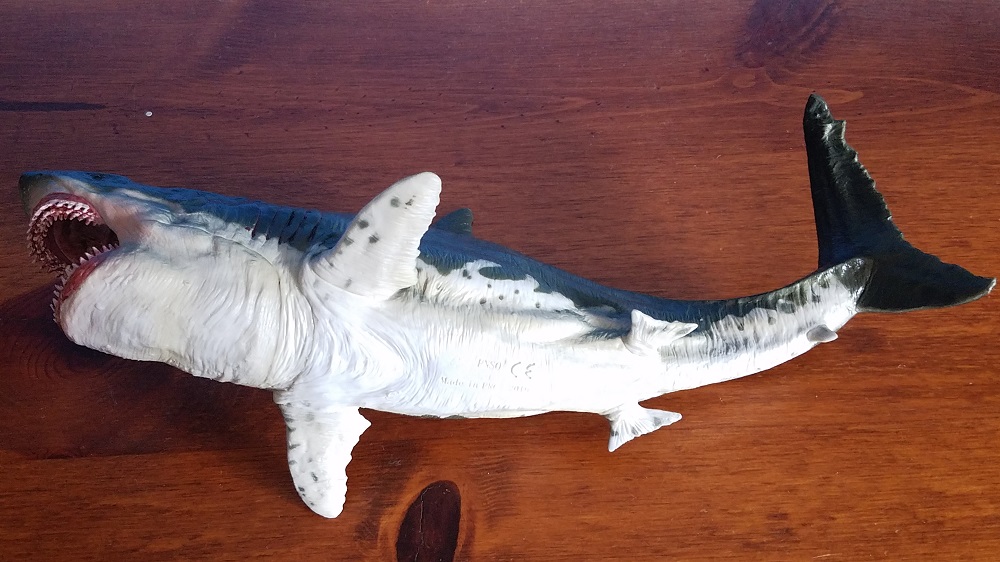
Unlike most shark figures, which depict traditionally smooth, streamlined anatomy, Patton’s body is intensely wrinkled with thick layers of skin. Muscles bulge along the flanks of the body and underneath the caudal keel. Heavy grooves run the edges of the fins and deep scars cut into the back of the shark’s body. The mouth gapes as wide open as possible, the rows of teeth splay outward, and the cavernous mouth is fully sculpted to show off the inner workings of the gills and throat. This isn’t necessarily a very realistic depiction of Megalodon, at least based on what we know of modern shark anatomy, but again, the result is a figure of a creature decidedly more formidable than anything alive today. If PNSO wanted a distinct look, they certainly achieved it.
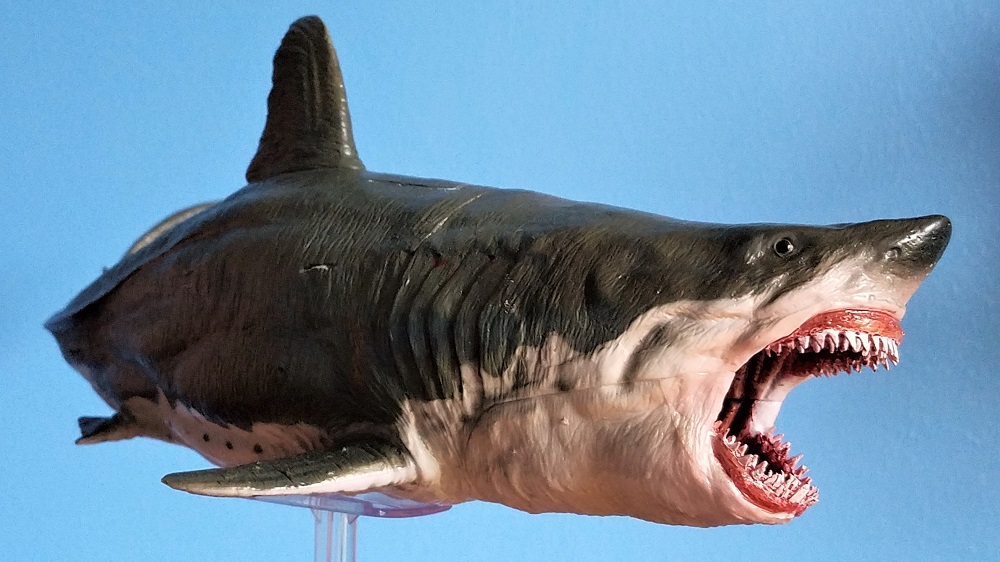
Patton is painted in the classic countershading pattern seen in many marine animals. The top half of the body has hues of very dark green with wiggly, spotted edges that give something of a grungy look to the figure. The belly is painted an off-white and bloody red highlights are applied to the gills and teeth, plus the fully-painted, raw red insides of the mouth. It’s a very well-applied paint job overall, with barely any slop on my copy of the figure. My only real complaint would be that the hard white colour of the body scars sticks out a little too much. Altogether, once again this is not necessarily a “realistic” rendition of the creature, opting for a more stylized, monstrous depiction; but the result is quite convincing and effective.

Patton the Megalodon might not be the definitive rendition of the giant extinct shark for those looking for a more scientifically plausible reconstruction, but PNSO’s vinyl figure is sure to please anyone who just wants a cool centerpiece for their prehistoric predator collection. PNSO has since released another, smaller Megalodon figure, but Patton can still be purchased for fairly reasonable prices at sites such as Amazon and AliExpress.
Support the Dinosaur Toy Blog by making dino-purchases through these links to Ebay and Amazon. Disclaimer: links to Ebay.com and Amazon.com on the The Dinosaur Toy Blog are often affiliate links, when you make purchases through these links we may make a commission

I prefer the CollectA version. This one looks too Hollywood.
Nice review of this impressive model.
Despite its flaws, I really like this one, the smaller one is nice but doesn’t have the impressive size that this one has.
Yeah, now that this genus is out of the way, I’m hoping to see PNSO tackle some of the other more exotic looking sharks!
We’re pretty overdue for a regular figure of Stethacanthus or Hybodus, I’d say!
Nice review. I wouldn’t mind seeing PNSO trying their hand at some other prehistoric fish that doesn’t a) require so much guesswork or b) so closely resemble living species, only bigger. For me personally, megatooth sharks are pretty much the only prehistoric fish I’m not interested in buying. And as long as I’m dreaming, I’d hope they’d avoid the excessive texturing of this model.
It is the best megalodon made to date in the toy dinosaur world. The second megalodon figure I like the most is the one from PNSO. Superb article.
My congratulations on your new acquisition. Honestly, Papo’s gorgosaurus is a very well accomplished, sculpted and painted figure of a tyrannosauroid that is not the tyrannosaurus rex. Most of the toy dinosaur figures not only the gorgosaurus look much better physically than seeing them in photos or videos.